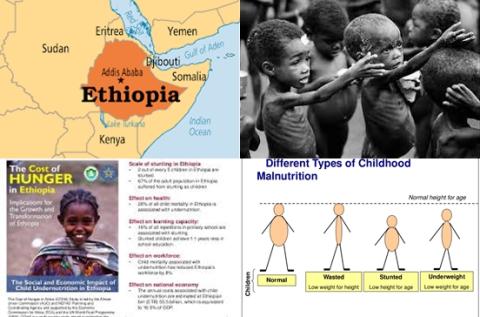
Objectives:
Undernutrition is the outcome of insufficient food intake and recurrent infectious diseases. The baseline levels of undernutrition remain so high that Ethiopia still needs to continue substantial investment in nutrition. Therefore, this review article (meta-analysis) has been conducted.
The aim of this review article is to obtain estimates of over-time trends in the prevalence of undernutrition in Ethiopia and to determine risk factors for undernutrition among children of under five years of age.
Study design:
This review article included 18 cross-sectional studies published in English from 1997 to 2015 focusing the prevalence of stunting, wasting and underweight in children aged 0-5 years (n = 39,585) in Ethiopia.
Sample size ranged from 100 to 10,449 participants. The majority (14/18) of the studies were conducted in rural and urban areas.
There was no publication bias.
Results and conclusions:
The investigators found the overall pooled prevalence estimate of stunting, underweight and wasting in Ethiopia was 42.0% [95% CI = 37.0 to 46.0], 33.0% [95% CI = 27.0 to 39.0] and 15.0% [95% CI = 12.0 to 19.0], respectively. The heterogeneity between studies was very high [I2 = 98.5% and p = 0.433].
The investigators found the highest prevalence of stunting was reported in East Ethiopia 67.8% and the least was in North Ethiopia 14.6%. The highest prevalence of underweight was reported in country level studies (DHS) (47.2%) and the least was in South Ethiopian studies (12%). Similarly, the highest prevalence of wasting was reported in country level studies (DHS) 42% and the least was reported in North Ethiopian studies (4.5%).
The investigators found that sensitivity analyses showed a prevalence of stunting of 40% [95% CI = 32.0 to 48.0, I2 = 99.19%], a prevalence of underweight of 33% [95% CI = 24.0 to 42.0, I2 = 99.34%] and wasting rate equal to 19% [95% CI = 14.0 to 24.0, I2 = 99.19%].
The investigators found cumulative analysis revealed a stabilization trend of stunting and underweight (1996-2010) followed by an upward trend (2010-2014).
The investigators found child age, child sex, complementary food, poor dietary diversity, diarrheal diseases, maternal education, maternal height, residential area and socio- economic status were significant risk factors for undernutrition in Ethiopia.
The investigators concluded that the trend of undernutrition in Ethiopia indicates that there is an increment of chronic malnutrition cases in recent years and the prevalence of undernutrition remains extremely high. Thus, the implementation of policies to reverse child undernutrition should get maximum emphasis.
Original title:
Nutritional Status of Under Five Children in Ethiopia: A Systematic Review and Meta-Analysis by Abdulahi A, Shab-Bidar S, […], Djafarian K.
Link:
https://www.ncbi.nlm.nih.gov/pmc/articles/PMC5440832/
Additional information of El Mondo:
Find more information/studies on food fortification/malnutrition and study design/meta-analysis/significant right here.